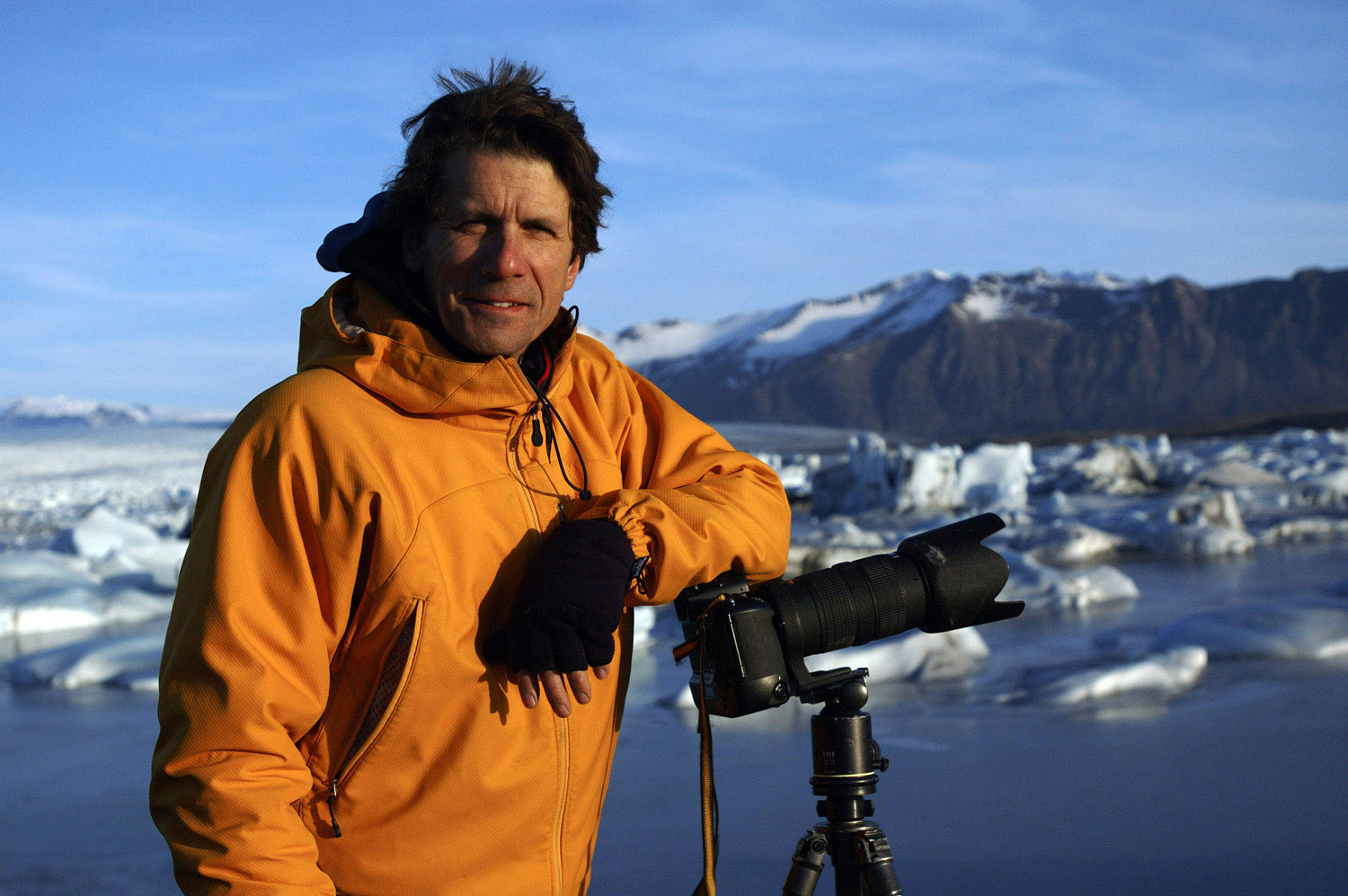
02 Apr Mountainfilm: Featured Speaker is Award-Winning Photographer & Filmmaker James Balog!
Passes for Telluride’s 2022 Mountainfilm Festival are on sale now! The stoke is at an all-time high as Mountainfilm returns to an in-person festival over Memorial Day weekend, May 26 – May 30, in Telluride, followed by After the Fest Online, May 31 – June 7.
Passes for both the in-person festival and After the Fest Online are now available for purchase here.
Go here for more on Mountainfilm.
And please scroll down to listen to our podcast with James Balog, a returning speaker at Mountainfilm 2022. Balog is, in fact, a Mountainfilm regular, having first presented in Telluride in the 1990s, then returning year after year to show his spectacular photographs and eco-focused documentary projects. His goal? Help move the needle on key issues facing our planet.

“(The Earth) sent you rain, sunsets, ripe cherries, night-blooming jasmine and that unbelievably cute person you are dating. Take the hint. And here’s the deal: Forget that this task of planet-saving is not possible in the time required. Don’t be put off by people who know what is not possible. Do what needs to be done, and check to see if it was impossible only after you are done,” Paul Hawken, renowned activist and former Mountainfilm guest speaker, from a book of essays titled “The Moral Ground.”
One take-away from the U.N.’s 2022 climate impacts report is that climate change is hurting our physical and mental health. Half of humanity is already vulnerable to water insecurity; billions more are at risk of extreme heat events, vector-borne diseases and hunger linked to global heating. Extreme weather has pushed millions more people into food insecurity at the same time climactic changes increases the likelihood of simultaneous crop failures just as staple foodstuffs are losing nutritional value.
And so on and on….
“People around the world are already suffering from the impacts of climate change at 1.1C of warming,” said Emily Shuckburgh, director of Cambridge Zero at the University of Cambridge in a story posted online. “Beyond 1.5C would put peace, security, economic stability and nature in peril across our planet and be an existential threat for far too many.”
The evidence of our 21st-century environment, based on irrefutable and unmistakable evidence, is that human needs, behaviors, and technologies are radically changing the nature of nature. This impact has given rise to the relatively new term, “Anthropocene,” which twins with our current epoch.
So then is it Man versus Mother Nature in a variation of a theme of Us versus The Other, Red versus Blue?
James Balog, author of nine books, an award-winning filmmaker and a one-time avid mountaineer, believes such divisive thinking is at the core of the problem. The conceptual breakthrough underpinning his latest book, an epic titled “The Human Element: A Time Capsule from the Anthropocene,” is that acknowledging the reality of the Anthropocene and dealing with its consequences should not be avoided, as conventional thinking about the environment would have us do.
Balog further clarifies in his introduction to his magnum opus (with an essay by Anne Wilkes Tucker and a foreword by James Fallows):
“There is no boundary, no contact zone, separating people from nature. There is no such opposition as ‘people’ and ‘nature,’ but only one unified state of being. In damaging nature we are damaging ourselves. In protecting nature we are protecting ourselves.”
The book featuring Balog’s compelling observations are at the center of his talk at Mountainfilm 2022, where the renowned photographer, filmmaker, environmental activist is a featured speaker. Again. (See below for more on Balog and his longstanding relationship with the game-changing festival.)
When James Balog first started seeing the world through a camera, he was a typical environmental romantic, enraptured by the natural world, longing for philosophical and spiritual union , and wanting to celebrate its beauty and grandeur. But emerging realities forced him to engage with other kinds of scenes. From that exploration, summarized in his monumental tome, comes a new vision of the relationship between human nature and the rest of the natural world as stated above.
“Balog’s investigation of human tectonics gives us fresh understanding of how the forces and deeds of humanity reshape fundamental characteristics of our environment. With essays and poems on such topics as witnessing the aftermath of the Indian Ocean tsunami, ascending into the treetops to photograph the giant sequoia Stagg, spending time as a wild-land firefighter, creating the incredible Extreme Ice Survey to photographically monitor glacier melt, and even struggling through his own battle with cancer, this definitive book is an unprecedented collection of photographic art informed by scientific knowledge. Featuring 350 of Balog’s most iconic images, THE HUMAN ELEMENT offers a truly unmatched view of our changing world – and a time capsule of humanity and our environment that may never be seen again,” explains his publisher, Rizzoli New York.
“Your magnum opus is clearly a landmark accomplishment, offering forceful reasoning for urgent action! … You deserve endless credit from the rest of us hapless humans for devoting your life and your astounding talent to ringing the alarm bell with a sharp call to action,” Elizabeth Broun, Director Emerita, Smithsonian American Art Museum.
“A collection of visually arresting, powerful, historical-marker photos of ‘the Anthropocene’ by one of the celebrated naturalists and photographers of our time. Physically the book is large, very heavy, and beautifully produced. It is like a museum exhibition, captured between covers. Since people don’t need printed dictionaries anymore, you’d want to put it on a dictionary stand—both so you don’t have to hold it, and so you can carefully leaf through its hundreds of arresting images. However, you can see this photographic record of our time—in this book, in the gallery exhibits that should resume someday, or otherwise—you should make a point of doing so. This is a beautiful, and alarming, and motivating portrait of our era.,” James Fallows, contributing writer to The Atlantic, former editor-in-chief of U.S. News & World Report, and former White House Director of Speechwriting.
“An epic and triumphant achievement that reveals the decades-long arc of a career of a master photographer and concerned naturalist—as well as his deep commitment to chronicling the adverse and ever-accelerating impact of humanity’s toll on our precious planet,” David Friend, Vanity Fair.
“In this riveting and visually rich drama, blending art and science, we follow renowned environmental photographer James Balog as he explores the impact of wildfires, hurricanes, sea level rise, a struggling coal mining community, and our changing air. With rare compassion and heart, THE HUMAN ELEMENT highlights Americans who are on the frontlines of climate change, inspiring us to re-evaluate our relationship with the natural world,” sums up Mountainfilm.
For more, listen to James Balog’s podcast in which he answers questions such as:
• How has your photography evolved and changed over 40 years?
• Do you think Homo sapiens’ impact on Earth’s systems, environment, processes and biodiversity are irreversible or do you remain guardedly optimistic?
• Why do you describe yourself as a detective?
• A certain cognitive dissonance arises when we learn that the man behind the camera was a hunter during his teens. Please explain.
James Balog, more:

In 2005, James Balog, on a tricky assignment for National Geographic, headed to the Arctic to capture images that would help tell the story of the Earth’ s changing climate. Even with a scientific upbringing – he holds a graduate degree in geology and geomorphology – Balog had been a skeptic about climate change and a cynic about the nature of academic research. But that first trip north opened his eyes to what is arguably the biggest story in human history.
In 2007, effectively “born again” Balog founded the Extreme Ice Survey (EIS), a long-term, innovative photography project that merges art and science to give a “visual voice” to the planet’s changing ecosystems by bearing silent witness to inconvenient truths. EIS remains the most extensive photographic study of glaciers ever conducted.
Directed by Jeff Orlowski, also a cinematographer for EIS and Mountainfilm 2022’s guest director, the documentary “Chasing Ice” tells the story of that mission to change the tide of history by gathering irrefutable evidence about the catastrophic results of a carbon-powered planet. “Chasing Ice” screened at Mountainfilm in 2012, and won an Emmy and an Oscar nomination.
(Go here for more on Orlowski.)
“Climate change is a universal human issue,” explains Balog. “It transcends politics and doesn’t belong to one party or another. The phenomenon has profound implications for the health, security, economics and food and water supply of every person on the planet, now and for generations to come. The San Juan Mountains in general and Mountainfilm in particular have been a tremendously inspiring presence in my life for a long, long time. I have always been really pleased for the chance to tell the story of how the world at large is changing and changing radically to my home-away-from-home crowd.”
Balog went on to make yet another major documentary titled, as his new book, “The Human Element.” The doc is a riveting and visually rich drama, blending art and science. The story tracks the renowned environmental photographer as he explores the impact of wildfires, hurricanes, rising sea levels, a struggling coal mining community and our changing air, while highlighting Americans on the frontlines of climate change, inspiring us to re-evaluate our relationship with the natural world.
Just as Mountainfilm does year after year.
Balog’s work has clearly traveled well beyond the borders of Telluride and Mountainfilm. “Chasing Ice,” for example screened six times at the UN, was shown to Congress, and to the House of Commons in London. Not to mention the White House. And a few years ago, Balog was invited to participate in the Bloomberg Energy Summit.
Bottom line: Over four decades Balog traveled well over a million miles from the Arctic to the Antarctic and the Alps, Andes, and Himalayas. With his images heightening awareness of climate change and endangered species, and breaking new conceptual and artistic ground on one of the most important issues of our era: human modification of nature.
His photographs are in dozens of public and private art collections and extensively published.


Sorry, the comment form is closed at this time.